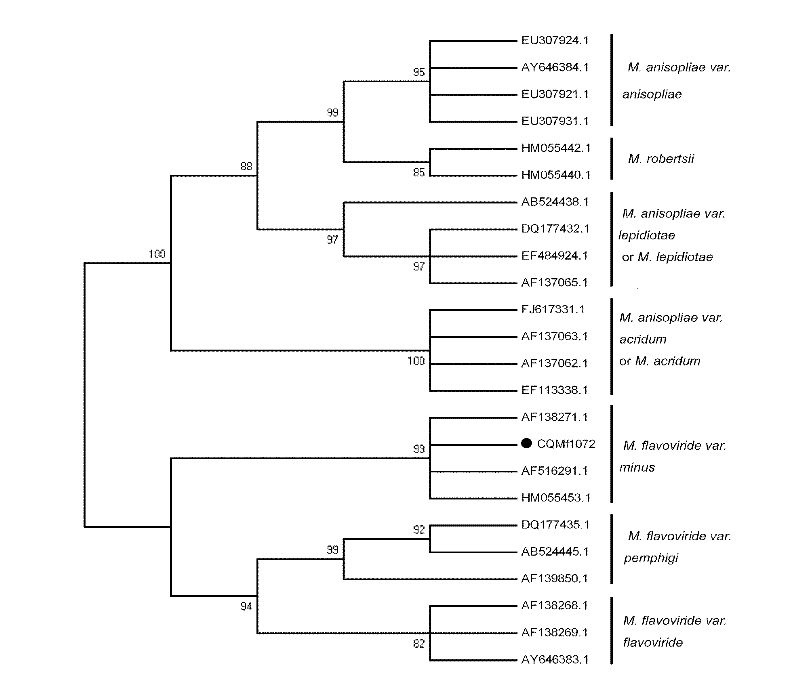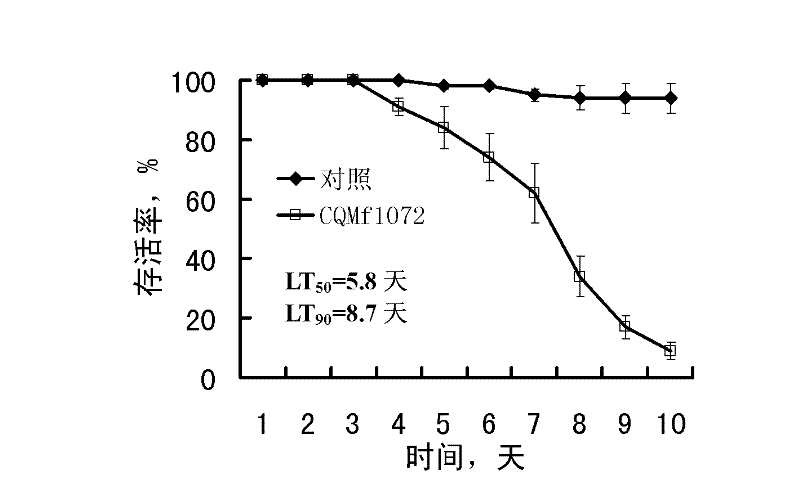Metarhizium flavoviride bacterial strain and application thereof
A technology of Metarhizium anisopliae and strains, applied in application, pesticides, biocides and other directions, can solve the problems of good production characters, lack of high insecticidal activity, etc., to achieve good production characters, control the number of populations, and good insecticidal effects Effect
- Summary
- Abstract
- Description
- Claims
- Application Information
AI Technical Summary
Problems solved by technology
Method used
Image
Examples
Embodiment 1
[0017] Example 1 Isolation of bacterial strains
[0018] Disinfect the surface of the collected naturally infected rice planthopper worms with 70% alcohol, put them in a 28°C incubator and culture them for 3-5 days, so that fresh spores grow on the surface of the insects; under sterile conditions, inoculate Pick a small amount of fresh spores and streak them on a PDA medium plate containing 100 μg / ml ampicillin; turn the streaked culture dish over and place it in a 28°C incubator for cultivation; after 3-4 days, pick out typical and For colonies free of miscellaneous bacteria, use a transfer needle to pick up a small piece of medium with hyphae at the edge of the colony, transfer it to the center of the culture medium on the slant of the test tube, and culture at a constant temperature of 28°C for 15 days.
Embodiment 2
[0019] Identification of embodiment 2 strains
[0020] (1) Morphological identification
[0021] The isolated CQMf1072 strain was inoculated on a PDA plate and cultured at 28°C to observe the morphological characteristics of the colony, the sporulation structure and the shape and size of the spores. The results showed that the colony was white cotton flocculent at the initial stage of culture on PDA medium, and olive green during sporulation. The hyphae are separated and branched, transparent, with a diameter of 1.4-1.8 μm; the conidiophores are solitary or aggregated or closely arranged, showing broom-like branches, with a diameter of about 2.2 μm, and the ends produce bottle-shaped stalks, 10.2- 16.1 × 1.5-2.5 μm; chained conidia are continuously formed from the end of the bottle stem, conidia are unicellular, oblong, and the size is 5.2-7.1×2-3.2 μm ( figure 1 shown). From the above characteristics, the strain CQMf1072 should be Metarhizium anisopliae microsporum var. ...
Embodiment 3
[0025] Example 3 Determination of Indoor Insecticidal Activity of CQMf1072 to Rice Leaf Roller
[0026] Collect the mature spores of CQMf1072 cultured on the PDA plate, disperse them with 0.05% (W / V) Tween-80, and make a final concentration of 1×10 8 spores / ml suspension. The rice planthoppers were transferred into 500ml triangular flasks with wheat seedlings, 30-50 rice planthoppers per bottle, sprayed with a spray tower (POTTER, BURKARD company), and inoculated with 50 μl. In 50-70% of the raw side chambers, 5 replicates were set up, and clear water was used as a blank control. Record the number of dead insects, calculate the survival rate, and obtain the fungal LT by statistical analysis of DPS2000 software 50 (when lethal) and LT 90 (lethal time).
[0027] from image 3 It can be seen that Metarhizium anisopliae CQMf1072 strain has obvious insecticidal activity to rice planthopper. At the peak of death 5-7 days after inoculation, the larvae of rice planthoppers becom...
PUM
 Login to View More
Login to View More Abstract
Description
Claims
Application Information
 Login to View More
Login to View More - R&D
- Intellectual Property
- Life Sciences
- Materials
- Tech Scout
- Unparalleled Data Quality
- Higher Quality Content
- 60% Fewer Hallucinations
Browse by: Latest US Patents, China's latest patents, Technical Efficacy Thesaurus, Application Domain, Technology Topic, Popular Technical Reports.
© 2025 PatSnap. All rights reserved.Legal|Privacy policy|Modern Slavery Act Transparency Statement|Sitemap|About US| Contact US: help@patsnap.com



